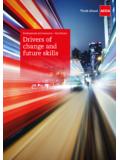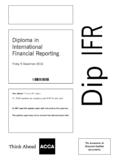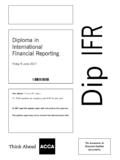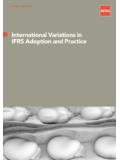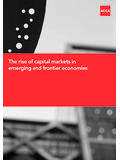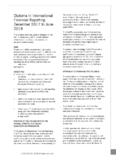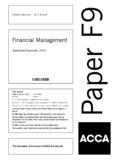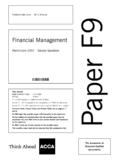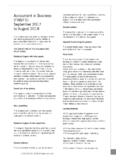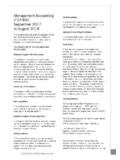Transcription of The impact of Covid-19 on Audit and Assurance challenges ...
1 The impact of Covid-19 on Audit and Assurance challenges and considerations Contents Introduction ..2. Identifying and Assessing Risks of Material The Auditor's Responses to Assessed Audit Evidence ..4. Auditing Accounting Estimates ..5. Subsequent Events ..6. Going Modifications to the Opinion in the Independent Auditor's Report ..8. Emphasis of Matter Paragraphs and Other Matter Paragraphs in the Independent Auditor's Report .. 10. Page 1 of 10 The impact of Covid-19 on Audit and Assurance challenges and considerations Introduction The unprecedented current situation caused by Covid-19 , has disrupted most professions across the globe with accounting and auditing being no exception. Mandatory lockdown measures were imposed by governments to control the spread of the virus, with individuals having to work from home where possible.
2 For auditors, this means they can no longer travel to audited entity premises, nor even to their own offices and that their audits will have to be completed remotely. If there is a positive side to this significant challenge for auditors, it is that the Audit profession was already on a journey to becoming more digital, and the investment in digital capability has allowed many firms and practitioners to adapt to the new circumstances relatively more quick than other industries. Notwithstanding this, a number of practical challenges have emerged. As ACCA's Covid-19 global survey: Inside Business, Impacts and Responses finds1, a significant 53% of respondents working in public practice said they were experiencing pressures completing client services work, and over a third (36%) said they faced an inability to meet reporting deadlines - a point recognised in many jurisdictions where reporting deadlines have been flexed.
3 A quarter said they're experiencing difficulties in gathering Audit evidence, and 27% said they saw an increased Audit risk relating to valuation of assets, completeness of liabilities or going concern issues. This paper highlights some of the practical challenges auditors are now faced with, in light of Covid-19 , and highlights some of the key considerations for auditors by referring to the relevant International Auditing Standards. The paper also refers to useful links published by regulators, standard setters and by other relevant stakeholders. ACCA is very grateful to the members of its Global Forum on Audit and Assurance for sharing their own practical experiences to support the development of this paper. Identifying and Assessing Risks of Material Misstatement ISA 315 (Revised), Identifying and Assessing the Risks of Material Misstatement Through Understanding the Business and its Environment, requires auditors to identify and assess the risks of material misstatement, whether due to fraud or error, at the financial statement and assertion levels, through understanding the entity and its environment, including the entity's internal control, thereby providing a basis for designing and implementing responses to the assessed risks of material misstatement.
4 Revision of Risk Assessment Additionally, paragraph 31 of ISA 315 (Revised) states that the auditor's assessment of the risks of material misstatement at the assertion level may change during the course of the Audit as additional Audit evidence is obtained. In circumstances where the auditor obtains Audit evidence from performing further Audit procedures, or if new information is obtained, either of which is inconsistent with the Audit evidence on which the auditor originally based the assessment, the auditor shall revise the assessment and modify the further planned Audit procedures accordingly. The unprecedented state of emergency caused by Covid-19 has impacted the operating environment of entities. As a result, auditors must consider how this impacts their risk 1 Page 2 of 10 The impact of Covid-19 on Audit and Assurance challenges and considerations assessments and whether any revision is needed.
5 This was also noted in the UK's Financial Reporting Council (FRC) Covid-19 Bulletin March 20202, which stated that, for audits which are underway relating to periods that end after 31 December 2019, the impact of Covid-19 is likely to require the auditor to revisit their risk assessment and the proposed response to identified risks. The Institute of Certified Public Accountants of Cyprus' Technical Circular 2/2020 [TC 2_2020]3. provides similar guidance, clarifying that risk assessments would need to be continuously reassessed and calibrated as the situation evolves, up until the Audit report signing date and emphasising this as an area that needs to be treated with a higher degree of professional scepticism. For example, as noted in ACCA's article on Covid-19 issues for corporate reporting4, the pandemic is likely to be a triggering event, requiring more frequent impairment testing and greater scepticism.
6 Given the heightened degree of uncertainty about future business performance and economic conditions affecting assumptions, valuations are likely to difficult to determine. As such, we expect more auditors to recognise an increased Audit risk in the valuation of assets. We also note that part of the auditor's risk assessment procedures as per ISA 315 (Revised), the auditor should also take into consideration any preliminary assessment performed by management regarding the entity's ability to continue as a going concern. Covid-19 is highly likely that would affect such preliminary assessments. ISA 570 (Revised), Going Concern paragraph 11 states, auditors should remain alert throughout the Audit for Audit evidence of events or conditions that may cast significant doubt on the entity's ability to continue as a going concern.
7 The challenges and considerations for auditors regarding the going concern assessment are discussed later in this paper. Furthermore, auditors must also take into consideration any changes to the entity's internal control system due to Covid-19 , and whether any planned reliance on controls in determining responses to identified risks of material misstatement should also be reassessed as noted in the IAASB's Staff Audit Practice Alert5. The Auditor's Responses to Assessed Risks ISA 330, The Auditor's Responses to Assessed Risks, requires auditors to respond to assessed risks by obtaining sufficient appropriate Audit evidence regarding the assessed risk of material misstatement, through designing and implementing appropriate responses to those risks. Paragraph 25 of ISA 330 states that, based on the Audit procedures performed and the Audit evidence obtained, the auditor should evaluate prior to the Audit conclusion, whether the assessments of the risks of material misstatement at the assertion level remain appropriate.
8 Covid-19 in many cases will necessitate auditors to consider if the design and implementation of their responses to the identified risks is still relevant or whether they need to be revised. 2 3 &refTableId=470&language=EL. 4 5 %20 Audit %20 Considerations%20 Arising%20from%20 Changes%20 Due%20to% Page 3 of 10 The impact of Covid-19 on Audit and Assurance challenges and considerations Audit Evidence ISA 500, Audit Evidence, requires auditors to design and perform Audit procedures to enable the auditor to obtain sufficient appropriate Audit evidence, from which to draw reasonable conclusions on which to base the auditor's opinion. However, due to the current restrictions in place due to Covid-19 , auditors in most, if not all cases, can no longer visit audited entity premises. This creates obvious practical challenges for auditors needing to obtain physical forms of evidence.
9 The use of technology can help auditors overcome these challenges . For example, auditors may not be able to attend planned inventory counts physically in order to observe the process. However, auditors may be able to observe inventory counts virtually via videocalls or drawing on drone technology. Auditors must ensure that they can rely on the technology they are planning to use and remain sceptical when observing the process. For example, they may need to consider asking their company staff to show them a clear view of the entire warehouse before the inventory count starts, which will avoid restricting themselves in choosing to test items that are only visible during the videocall. It is also very important that the process followed is well documented. Some practical examples noted by ACCA's Audit and Assurance global forum members included: Participation of more than one member of the Audit team during observation through video- conferencing equipment to enhance the observation capabilities and mitigate the risk Selecting more items to test during observation than usual Taking screenshots during the observation to enhance the evidence Some forum members also noted that, for audits with deadlines close to the dates of implementing the lockdown orders, they had some late switch at a late stage from mailed paper-based confirmations to electronic confirmation.
10 Although this started initially as a temporary change for some practitioners, most of them are now seeking to obtain electronic confirmation universally given the current circumstances. Paragraph 4 of ISA 501, Audit Evidence - Specific Considerations for Selected Items states that if inventory is material to the financial statements, the auditor should obtain sufficient appropriate Audit evidence regarding the existence and condition of inventory by: a) Attendance of physical inventory counting, unless impracticable. b) perform Audit procedures over the entity's final inventory records to determine whether they accurately reflect actual inventory count results. In cases where the inventory count is scheduled at a date other than the financial statements period end, auditors will need to perform additional Audit procedures to obtain evidence regarding the changes in inventory between date of the inventory count and the financial statements date.
